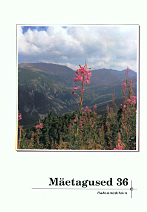Naturaliseerunud ravimtaimed etnobotaanika vaatenurgast
Naturalized medicinal plants from the viewpoint of ethnobotany
Author(s): Raivo KalleSubject(s): Customs / Folklore
Published by: Eesti Kirjandusmuuseum
Keywords: history; medicinal plants; cultivated plants; plant names; phytonyms; naturalization; ethnobotany
Summary/Abstract: The paper gives an overview of six plants, naturalized in Estonia: butterbur (Petasites hybridus), chicory (Cichorium intubus), elecampane inula (Inula helenium), horseradish (Armoracia rusticana), soapwort (Saponaria officinalis) and sweet violet (Viola odorata).The approach to their naturalization is based on ethnobotanical rather than biological qualities. The first disseminators of foreign plants were merchants. The earliest cultivators may have also been monasteries, although it is not known what exactly was grown in these gardens. The most important plants cultivated in monasteries were herbs, which were planted in 4-12 beds, vegetables in 9-18 beds, whereas the rest of the garden was reserved for an orchard. The establishing of the first pharmacies in Estonian towns introduced the planting of new species in gardens for sale (the earliest pharmacy, the Tallinn Town Hall Pharmacy, dates back to 1422, with a herb garden founded in 1452). The oldest preserved list of plants growing in pharmacy garden originating from Narva pharmacy from the year 1677 contains already following herbs: chicory, elecampane inula, butterbur and sweet violet. Next to pharmacies, foreign species were also disseminated by grocers and drugstores. A century later, in 1777, the list of tracheophytes found in Estonia and Livonia was compiled; this list has been considered the first written source in the field of botany. In the list all the six plants were noted as natural species. The spread of the plants was speeded by their versatile usage - all these plants were used as medicines; chicory, horseradish and elecampane inula were also vegetable plants; elecampane inula, sweet violet, soapwort and butterbur were popular landscape plants; soapwort was used to clean silk and wool. Various legal acts, which have been applied to the plants, have also influenced their spread. Elecampane inula was listed in the first Estonian dictionary in 1660. Translated literature became an important factor in introducing herbs into broader use. Already the first journal (published in 1766-1767) and the earliest popular medical book (1771) in Estonian describe the use of horseradish, butterbur, elecampane inula and sweet violet. The plants, especially garden horseradish, are repeatedly mentioned in almanacs and books published since. The use of chicory is described only once in 1895, and soapwort once in 1870. The paper describes in more detail the formation of new ethnic names. The plant names were mostly derived from adaptations of German names (e.g. aland, pestilens-wurtsel, wiola, sigur, etc.), later from German translations (e.g. katkujuur for butterbur) and in some cases, the name of the local plant was used to mark a similar new plant (e.g. sinilill, or hepatica, for sweet violet and põierohi, or campion, for soapwort).
Journal: Mäetagused. Hüperajakiri
- Issue Year: 2007
- Issue No: 36
- Page Range: 105-128
- Page Count: 24
- Language: Estonian

